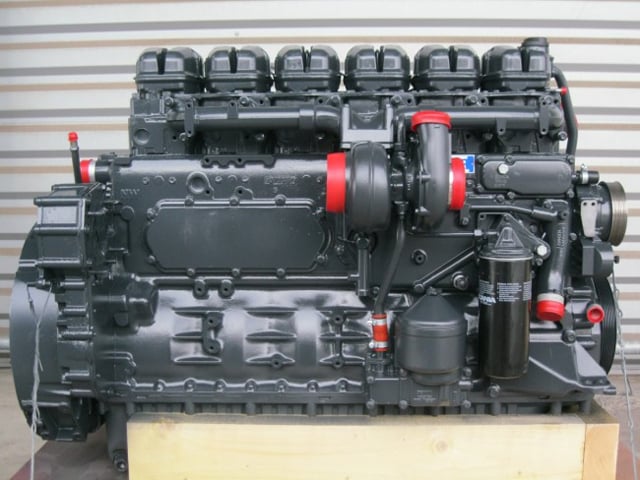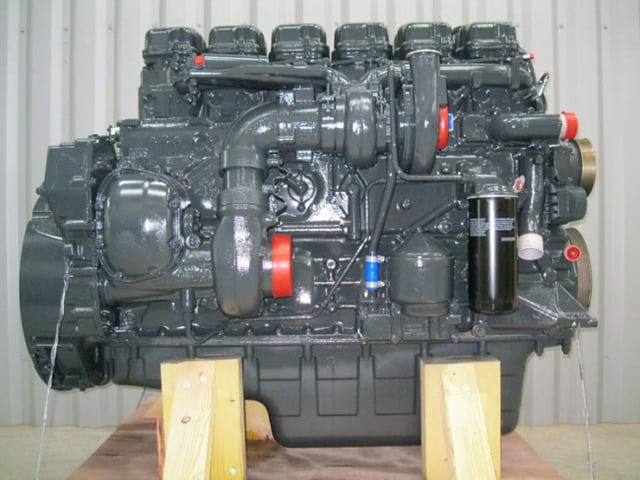The world has experienced diesel in ways much different than how we understand it here in the States. Here, all we can really choose from is either a Cummins inline-four or inline-six, an EcoDiesel V6, or a Power Stroke or Duramax V8. Abroad, companies like Volkswagen have really stretched the applications of diesel to amazing levels.
But wait a minute, aren’t we talking about the same Volkswagen diesel that kicked off Dieselgate? The same Volkswagen that led our beloved combustion process to ferocious government scrutiny? Well, yes, we are. But litigation and scandal notwithstanding, it turns out the company has taken some big strides in what was thought possible with diesel.
Today, we’ll look at the current Volkswagon diesel motors offered by VW worldwide, since attempting to include its entire repertoire of oil-burning powerplants would take quite a lot of time (and bandwidth) to do. Our first model will be a two-pot motor, the R2 TDI.
Inline-two: R2 TDI

Photo: forums.vwvortex.com
Ever held a one-liter bottle of soda from a gas station? In less than that same volume of space, Volkswagen was somehow able to make a diesel engine complete a full cycle of combustion. Case in point: the R2 TDI.
Only available on one application – the 2014-present XL1 – the engine was also supposed to go into a concept called “twin up!” that rolled out in late 2013. The R2 TDI is part of a dual powertrain, with the other half being a 60-cell lithium-ion battery positioned at the front of the vehicle, while the diesel motor rests in the rear.
Inline-three: R3 12V TDI, R3 TDI PD

The R3 TDI. Photo: Car Magazine
For three-cylinder motors, Volkswagen offers a couple of options: the R3 12V TDI, and the R3 TDI PD. The first R3 is a 16-valve model that has 1.2 liters of displacement and uses a cast iron block. It’s good for 74 hp and 133 lb-ft of torque, and can be found in 2009-present Polo Mk5s, 2010-present SEAT Ibiza Mk5s, 2010- Škoda Fabia Mk2s, and 2010-present Škoda Roomsters.
The second R3 has 1.4 liters of displacement and uses a graphitic iron block. It generates between 68-89 hp and 114-170 lb-ft of torque depending on the application, and can be found in several models from 1999-present, including the Audi A1, Škoda Fabia, Škoda Roomster, and Volkswagen Polo.
Inline-six: DC12/DT12 EU4, DC12 EU5, DC13 EU5
The DC12 (left) and DT12 (right), two straight-six motors made by the Volkswagen Group in service of large, 18-wheeler trucks. Photo credit: graffeuille.co.uk
Any of VW’s straight-six engines are not going to be found in passenger cars, at least not without monumental engineering and thought-experimenting feats. These mills are reserved for Scania trucks, similar to our 18-wheelers, except that they haul cargo all along the Autobahn instead of Interstate 66.
The large nature of the Volkswagon diesel engines is dictated by their displacement. The DC12/DT12 EU4 churns 11.7 liters of air in a full cycle, and by virtue of that can generate up to 473 hp and 1,660 lb-ft of torque. “EU4” refers to the Euro 4 emissions standards, which in this case dictate that the engines make no more than 0.50 grams of carbon monoxide per kilometer, .30 grams of hydrocarbons and nitrous oxide compounds per kilometer, .25 grams of nitrous oxides per kilometer, and .25 grams of particulate matter per kilometer. These standards were in effect from January 2005 to September 2009.

The DC12 EU5. Photo: wheelsage.org
Up from there, the Volkswagon diesel DC12 EU5 came into effect. It also had an 11.7-liter displacement, and could generate 414 hp and 1,549 lb-ft of torque, indicating a drop in output; this was likely due to the inclusion of SCR technology into the trucks.
The next evolution was the 12.7-liter DC13 EU5, which switched from high-pressure to extra-high-pressure common-rail direct injection, and added two-way exhaust gas recirculation to stay in spec for Euro 5 regulations. The trucks could now make great numbers again, with a high of 473 hp and 1,844 lb-ft of torque.

The DC13 Euro 5. Photo: wheelsage.org
V6: V6 TDI CR, V6 24V TDI CR, V6 24V BiTDI CR
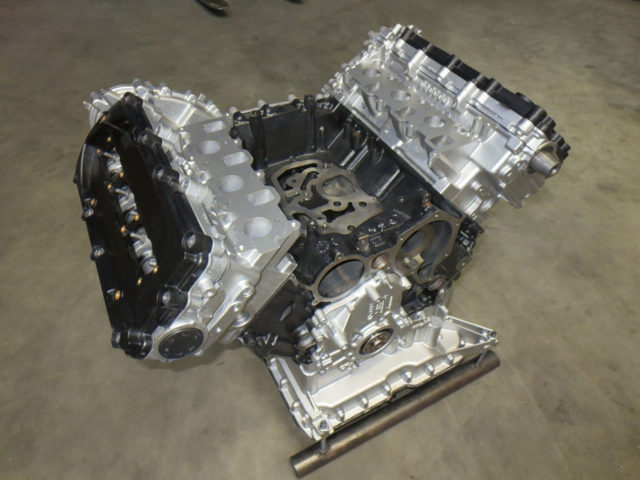
The 2.7-liter V6 TDI CR, as found in the Audi A4 and A5. Photo: ebay.co.uk
The 2.7-liter V6 TDI CR has a compacted vermicular graphite cast-iron block and crankcase, and cast aluminum heads. It uses common-rail (CR) direct injection and can inject fuel at up to 1,600 psi. It’s found on the 2005-08 Audi A4, 2007-08 Audi A5, and 2005-08 Audi A6.

The 3.0-liter, 24-valve V6 TDI CR., seen here in a marine application. Photo: Wikipedia
The Volkswagon diesel 3.0-liter V6 24V also uses a compacted vermicular graphite cast iron block and crankcase, and has the added efficiency of four valves per cylinder. One interesting aspect of the 24-valve is that it is also used in boats, where it can make up to 261 hp and 406 lb-ft of torque. At its most highly tuned state, it can make up to 268 hp and 428 lb-ft of torque, like it’s found in the 2014-present Audi A7.
The final version is a biturbo arrangement (BiTurbocharged Diesel Injection, or BiTDI) that’s good for 315 horsepower and 479 lb-ft of torque. This version is found in the 2014-present Audi A6 and A7.
V8: V8 TDI CR, V8 DC16
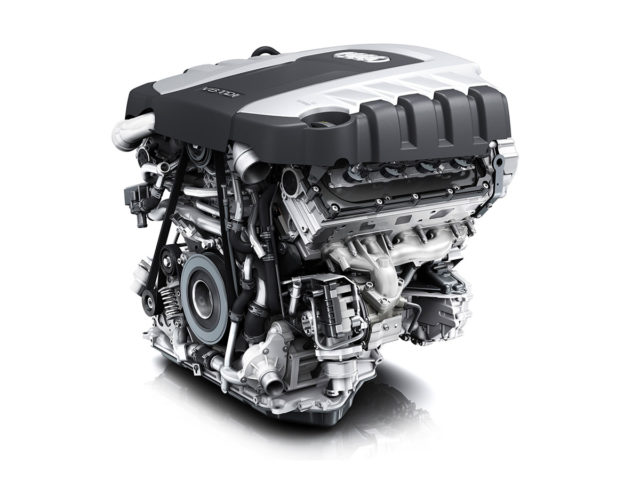
The 4.2-liter V8 TDI. Photo: fourtitude.com
Eight screamin’ cylinders is what a lot of folks here in the States prefer. In the case of Volkswagen, the 4.2-liter, biturbo engine has all of the hallmarks of a killer mill. At its peak, it can make up to 345 hp and 590 lb-ft of torque, but that’s reserved for boats. Car-wise, it offered the 2007-09 Audi Q7 a hefty 322 hp and 561 lb-ft of torque.
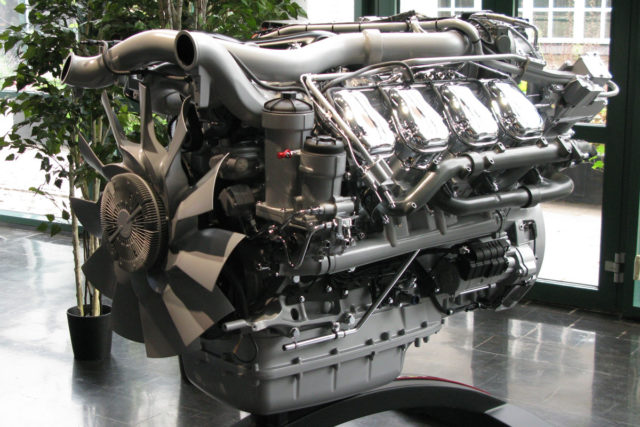
The 15.6-liter DC16 V8. Photo: Wikimedia
A V8 like that may be fun and games, but the jokes stop when it comes to the DC16. Able to churn a whopping 15.6 liters of air in full combustion cycle, the mighty motor is – you guessed it – reserved only for the large Scania shipping trucks. At its utmost, the DC16 can make up to 730 hp and 2,655 lb-ft of torque – just a scary amount of power!
V10: V10 TDI PD Volkswagon Diesel
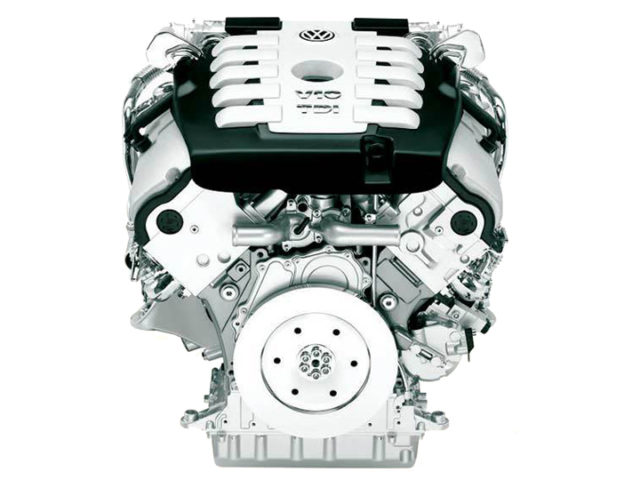
The 4.9-liter/5.0-liter V10 TDI. Photo: vwvortex.com
Back when we covered the diesel motors of BMW, we had to halt at V8s. BMW only has one in its current catalog, but Volkswagen has boldly gone where few others have dared and made a V10 and V12 (which we’ll get to in a moment) to give the world some badass diesel power.
For some background on this motor, it was originally developed for the Volkswagen Phaeton – a full-length, four-door saloon made to compete with the Mercedes-Benz S-Class or Lexus LS. Then-chairman Ferdinand Piëch directed his engineers to make a vehicle that could drive near 200 mph for hours on end in 120-plus-degree Fahrenheit weather, and still keep its passengers happy at 72 degrees Fahrenheit on the inside.
A number of gasoline motors were made for the car (including an impressive 6.0-liter W12), but diesel-wise, the biggest was the 5.0-liter V10 TDI. It could make 346 hp and 627 lb-ft of torque, and had a low-pressure, die-cast aluminum engine block with 20 valves and 10 29,730-psi injectors.
V12: V12 48V TDI CR DPF Volkswagon Diesel

The 6.0-liter V12 TDI. Photo: YouTube
The meanest, maddest mother of them all has to be Volkswagen’s V12 diesel. Truthfully, it’s a product of Audi’s qauttro division (think SRT for Dodge, or Ford Performance for Ford). It has a displacement of 5.9 liters, water-cooled dual turbochargers, Bosch 29,101-psi injectors, and a host of other high-falutin’ upgrades to keep it running in peak form.
So what vehicle would receive such a beast? The answer is the Audi Q7, from 2008 to 2012. At its debut, it was the first-ever V12 diesel motor to ever be given to the masses to drive around in. For their troubles, owners could expect terrific output numbers: 490 hp and 740 lb-ft of torque, to be exact.
But where, if at all, will the next Volkswagen diesel come from? Dieselgate’s ongoing litigation has effectively put a kibosh on the automaker from developing any oil-burners in the near future. Perhaps the stigma of Dieselgate will never go away, and kill VW’s interest entirely.
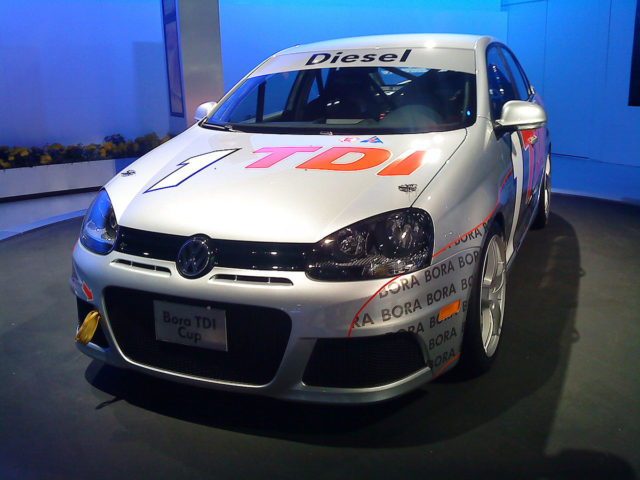
Will the sting of Dieselgate ever subside? Maybe, maybe not. Photo: Wikimedia
Regardless of the circumstances, it’s still amazing to see what Das Auto was able to come up with in this day and age. Which of these Volkswagon Diesel engines is your favorite? Let us know in the comments below.



